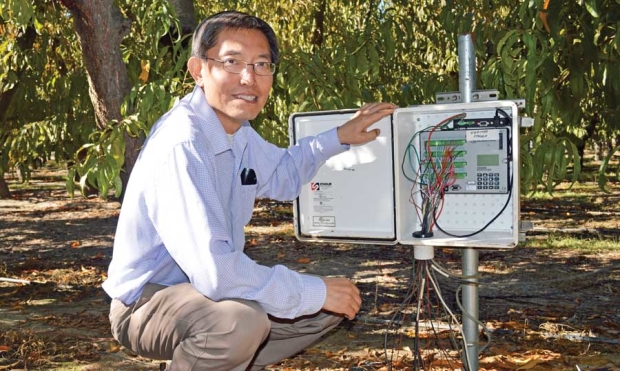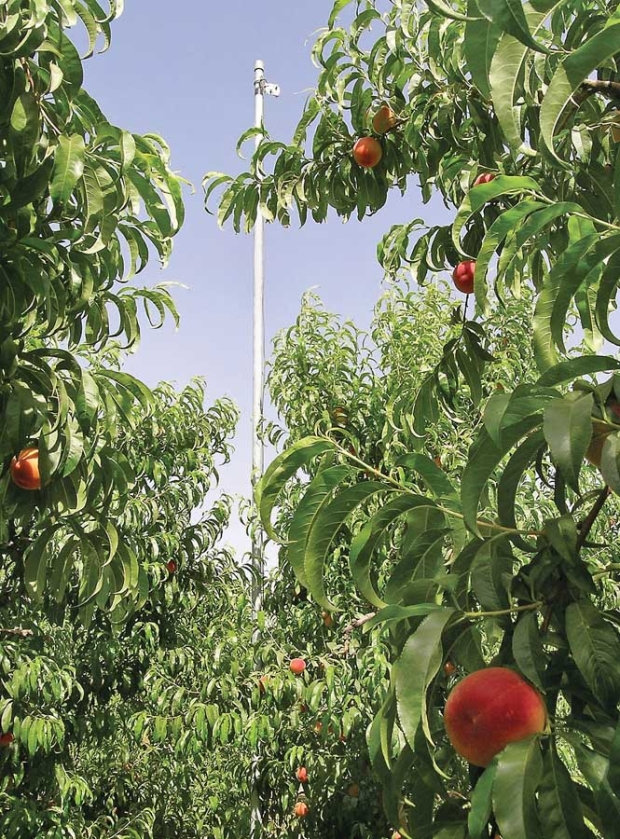
Dong Wang, research leader with the San Joaquin Valley Agricultural Sciences Center’s Water Management Unit, shows a data logger used to record information from soil moisture sensors placed at various depths. (Vicky Boyd/for Good Fruit Grower)
Growers of early-season peach varieties in California’s Central Valley may be able to conserve water without significantly affecting yields by cutting postharvest irrigation in half.
An added benefit is that deficit irrigation lessens the amount of mid-season vegetative growth, reducing the amount of pruning and labor needed.
These are but a few of the results of a series of related stone fruit irrigation studies led by U.S. Department of Agriculture Agricultural Research Service scientists at the San Joaquin Valley Agricultural Sciences Center near Parlier.
Although the work began nearly a decade ago, Drs. James Ayars and Dong Wang said the information they’re gleaning about more efficient irrigation practices for stone fruit growers is especially relevant after four years of drought.
“Drought’s a way of life in California,” said Ayars, a research agricultural engineer. “Hopefully this will be a wake-up call, and people won’t revert back to their old ways.”
Early-season peach varieties are typically harvested in late May or early June, but about two-thirds of the irrigation is applied after harvest during the hottest part of the growing season.
Ayars likened the water use to a bell curve, with harvest occurring at the beginning of the upward trend. His trials involved a four-acre block of Crimson Lady peaches, which mature typically in late May.
The trial also involved three different types of irrigation: furrow, subsurface or buried drip, and microspray.
Although some older orchards still use furrow irrigation, he said most of the newer ones rely on microsprinklers or drip irrigation. One of the challenges with furrow irrigation is you have little control over the depth of the water applied.
“For the most part, you can’t put on small amounts of water, and that’s the advantage of drip or any pressurized system — you have good control on the depth of application,” Ayars said. “You can still find furrow irrigation around here, but more and more people are moving to microsprays and microsprinklers or surface drip.”
Third-generation stone fruit grower Bill Chandler is one of those moving to microsprinklers when he plants new stone fruit orchards.
A longtime supporter of research, the Selma producer has adopted regulated deficit irrigation in his wine grapes and almonds and year-round integrated pest management, among other practices.

An infrared thermometer mounted on a pole measures peach tree canopy temperatures under regulated deficit irrigation. Canopies of stressed trees have a higher temperature than nonstressed trees. (Courtesy Agricultural Research Service)
But Chandler said he is cautious about reducing peach irrigation because of the potential for split pits and other fruit defects. Nevertheless, he remains interested in research that would help the industry better manage water.
“It’s important because we’re worried about having enough water because of the drought,” he said. “So if we can be more efficient with the water and when we’re applying it on the trees, that would be beneficial.”
As part of Ayars’ trial, the trees received full irrigation, or 100 percent of the evapotranspiration (ET) rate, from March through May harvest.
Then randomized blocks received 100, 50 or 25 percent ET following harvest until the end of the season.
All blocks received the same commercial thinning, pruning and fertilizer treatments.
At the end of each harvest, researchers counted and removed defective fruit. They then counted, weighed and mechanically sized the remainder of the crop.
Stress that occurs one summer can affect developing buds for the following year’s crop. As a result, the researchers noted that trees that received only 25 percent ET had significantly reduced yields and quality the second year. The fruit also had more deformities.
Because of the negative impact 25 percent ET irrigation had on the crop, Ayars said he would not recommend that practice to growers.
But by cutting later-season irrigation in half, growers could see 50 percent savings in postharvest water use with no significant differences in yield or deformities compared to trees that received full ET.
Wang, research leader with the center’s Water Management Unit, continued work in the same peach orchard to examine whether infrared sensors and thermal technology could be used to characterize plant water stress based on plant canopy temperature.
As temperatures rise, loss of water vapor through leaf pores — or stomata — cools the plant. When water loss from the leaves exceeds what the plant can take up from the soil through roots, the stomata shut down and the plant heats up.
The temperature of the plant has been used previously as a measure of the stress in some field crops.
Thermal technology and hand-held infrared sensors were used by cotton growers in the 1970s to monitor crop health.
Wang and ARS agricultural engineer Dr. Jim Gartung placed infrared temperature sensors above the tree canopy in the orchard.
In a well-irrigated orchard, tree temperatures can be about 2°C — about 35°F — lower than the ambient air temperature, Wang explained. But as trees become stressed, the difference may reverse, with canopy temperatures exceeding ambient air temperature by more than 4°C (about 39°F) under extreme conditions.
These trials compared thermal technology readings to soil moisture sensor data and midday stem water potential readings from a pressure chamber to determine how well the results correlated.
The researchers found canopy temperatures that were approximately 2°C warmer than the surrounding air correlated to about a 50 percent deficit irrigation while fruit size was not affected, Wang said.
In his latest research, Wang has begun working with a canning peach grower near Kingsburg to gain a better understanding of the water requirements of a tree’s various growth stages.
The project differs from the work at Parlier because it involves a later-season canning peach variety. It also will examine how a grower’s typical irrigation regime matches up against the tree’s water requirements.
“One of the things I think is pretty common in California is most growers don’t have water meters for surface irrigation,” Wang said.
Instead, many growers know the gallons-per-minute flow and run water for a set number of hours. Good water management requires an accurate measurement of applied water and that requires precise measurement of flow, he said. •
– by Vicky Boyd






Articles about irrigation always seem to go so far but fail to answer some fundamental questions. For example, which is the right way to apply deficit irrigation? Do you irrigate at the same interval but with less water? Or, do you apply the same dose but less frequently?
I spent five years measuring soil moisture for some 100 customers and this is what I learned.
Trees extract water from the soil starting at the top. The top 12 inches are easier to extract for obvious reasons. Once the top soil is nearing the stress point, the deeper roots kick in and so on down the profile. For some crops the roots are able to work efficiently at depth and the total daily water use is the same whether the trees are working at 12 inches or at 36 inches. For others, the total daily water use decreases as the roots explore at depth.
Rain or irrigation first fills the top soil and as more is applied the lower layers are progressively filled. This is like a stack of wine glasses: you have to fill the top one before the next starts to fill.
If you irrigate at the same interval but with less water, only the surface layer roots will be active. This has implications for nutrition as the fertiliser available in the surface layers will soon be used up; the tree roots will not extract fertiliser from depth if they are not extracting water too. On the other hand, if you operate a deficit policy by applying water to depth but less frequently, the trees will gradually become more stressed over the course of the irrigation interval. For the first few days they will have plenty, but gradually they will have to work harder for the water. So growth will be a series of fits and starts.
Which strategy is best?
[…] Strategies for saving water Dong Wang, research leader with the San Joaquin Valley Agricultural Sciences Center's Water Management Unit, shows a data logger used to record information from soil moisture sensors placed at various depths. (Vicky Boyd/for Good Fruit Grower). Read more on Good Fruit Grower […]